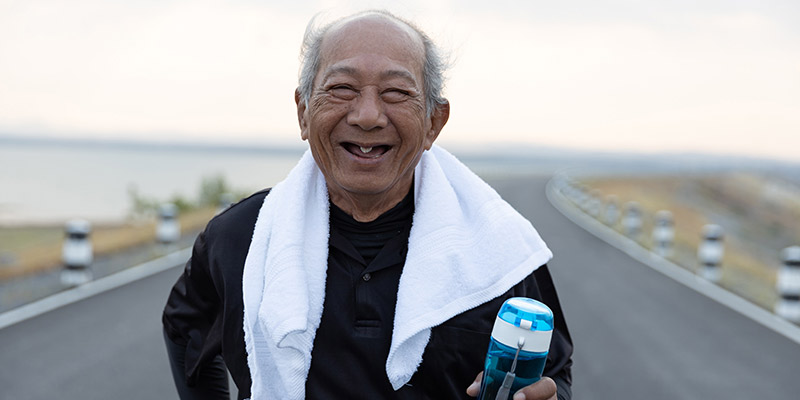-
Need a little extra support?
Going to hospital?
If you’re an eligible member with hospital cover you can speak to our Health Concierge# to get support and guidance before and after your hospital stay. Call 1800 789 414 between 9am—5pm AEST (Mon-Fri). Just be sure to have your Medibank membership details ready.
Got a health question? 24/7 Medibank Nurse Support
Medibank health insurance members can chat to a registered nurse over the phone or online to discuss general health questions or concerns at no extra cost.~ Chat online or call 1800 644 325 24 hours a day, 7 days a week.
Recovery time for knee or hip replacement can vary. It can take several months to feel the full benefits of your new joint, but as you work through your rehabilitation, you’ll notice that things gradually improve and you can return to more activities you enjoy.

A physiotherapist will show you exercises that will improve your mobility, strength and stamina. Make an extra effort to stick to your exercise program—it can make a big difference to your recovery.
Some pain, discomfort and swelling are normal, but that doesn’t mean you should just try to ignore them. It’s important to manage these symptoms so you can stay active. Read on for tips and information to help you after a joint replacement.
Manage pain
Some pain and discomfort is normal after a hip or knee replacement, particularly when you increase your activity levels or do your physiotherapy sessions. Some tips for managing pain after knee or hip replacement surgery include:
- Take pain relief medicines as prescribed. Regular pain relief can help prevent pain from getting worse.
- Don’t wait for the pain to get bad before you take pain relief medicine. This makes it harder to manage
- Regular pain relief can make it easier to complete your exercises and make you more likely to get up and move around, which is important as you recover.
- Time exercises for 30 minutes after your pain relievers when the medicine is at its most effective.
- See your doctor if you are having trouble coping with pain.
Manage swelling
Swelling is normal after a hip replacement or knee replacement—but it can increase pain and reduce your range of motion, so don’t just grin and bear it.
- Cold packs and ice can reduce discomfort and swelling, especially after exercise. Ask your physio how often to use them and how long to keep them on for. Be sure to put a wet towel between the ice or cold pack and your leg to avoid ice burns.
- Elevating your leg with pillows can also help after a knee replacement. Keep your knee straight when it’s elevated—and don’t keep it elevated overnight.
- Talk to your physio or doctor if you’re really stiff and think you may have overdone it.
Exercise
It’s important to start gentle activity sooner rather than later after joint replacement surgery. Staying active will help you maintain strength, flexibility, and endurance, and can reduce the risk of blood clots.
Remind yourself that keeping active will help you recover faster, and you’ll actually feel less tired and have more energy if you get up and move around.
Walking, swimming (once your wound has fully healed), aqua aerobics, or cycling on a stationary bike are all low impact activities you can include. Just make sure to have a physio check that your bike is properly set up to reduce your chance of injury. Your surgeon will talk to you about what precautions you’ll need to take and for how long.
Make your joint last
Some types of exercise are generally not recommended even after you’ve fully recovered because they put a lot of extra stress which shortens the lifespan of your new joint. These include high impact or contact sports that involve jarring, twisting or sudden changes in direction, as well as activities that involve jumping, jogging or running.
Taking it easy
Your fitness should return to normal after three months if you stay active, but your balance and coordination take longer. It may be six months or more before your new joint feels completely normal.
Keep up healthy habits
Don’t stop your healthy habits when your rehabilitation ends. Setting goals can help you keep focused, but don’t be discouraged if you have a down day, or don’t achieve your goals for a particular day or week. Just start the next day fresh. Any small steps you take will improve your overall wellbeing.
Keep on top of any other health issues
Often when people leave hospital, they find themselves focusing a lot on whatever sent them to hospital in the first place. But if you have any other health conditions, it’s especially important to keep them under control.
Make sure you have an up-to-date plan to manage any other health conditions you have, and see your GP regularly. The last thing you need while you recover is a flare-up or to head back to hospital.
Prevent blood clots (also known as deep vein thrombosis or DVT)
Just like going on a long-haul flight, knee or hip replacement surgery increases your risk of a deep vein thrombosis (DVT). This is a blood clot that forms in one of your deep veins, usually in your leg.
DVT can cause pain and swelling in your leg and lead to serious long term issues, and it can be fatal if the blood clot moves into your lungs
You can reduce your risk of DVT by:
- Wearing compression stockings if your physio or surgeon recommends them
- Getting up and moving around regularly (and as soon as possible after surgery)
- Moving your feet up and down every half hour if you are sitting or lying down for long periods of time
- Drinking enough water
- Taking certain medications or using a special pump to encourage blood flow, if prescribed by your doctor.
See your doctor as soon as you can if you notice pain or swelling in your calf, thigh, ankle or foot.
Recognise warning signs
While you recover from surgery, it’s important to look out for warning signs of infection and blood clots. The quicker you recognise an issue, the quicker you can deal with it and get back to focusing on your recovery.
Signs of infection include:
- Fever (temperature over 38°C)
- Swelling, redness or tenderness near your wound
- Anything oozing from your wound
- Shaking or chills
- Rapid breathing
- Mental confusion
- Dizziness or feeling faint or lightheaded
- Pain when you wee or blood in your urine.
Contact your doctor (or emergency department if after hours) if you experience any of these symptoms.
Signs of a blood clot or DVT include:
- Tenderness, redness and swelling in your leg, ankle, or foot
- Pain in your leg, ankle, or foot
Contact your doctor as soon as you can if you experience any of these symptoms.
Signs of a blood clot in your lung include:
- Shortness of breath
- Chest pain
- Rapid pulse
- Coughing up blood
- Feeling dizzy or faint.
Call 000 if you experience any of these symptoms.

Looking for something else?
Visit our Hospital Assist homepage for a range of tools and advice to help you at every stage of your hospital journey.
Help the way you want it
Contact us
Call us on 134 190 to speak to a consultant. Alternatively, chat to us 24/7 online.
Self-service options
Login to MyMedibank or Download the MyMedibank App for self service options.
Find a specialist
Find a specialist or Member's choice hospital using our find a provider tool.

Sources
https://www.healthdirect.gov.au/deep-vein-thrombosis
https://www.ncbi.nlm.nih.gov/pmc/articles/PMC3262341/
Things you need to know
# Health Concierge is available to all eligible Medibank members who hold hospital cover. Excludes Overseas Visitor Health Cover, Working Visa Health Cover and Overseas Student Health Cover (OSHC).
~ Some referred services may involve out of pocket costs and waiting periods may apply.
While we hope you find this information helpful, please note that it is general in nature. It is not health advice, and is not tailored to meet your individual health needs. You should always consult a trusted health professional before making decisions about your health care. While we have prepared the information carefully, we can’t guarantee that it is accurate, complete or up-to-date. And while we may mention goods or services provided by others, we aren’t specifically endorsing them and can’t accept responsibility for them. For these reasons we are unable to accept responsibility for any loss that may be sustained from acting on this information (subject to applicable consumer guarantees).